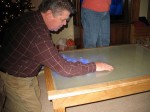Interactive LED Table
Posted 2007-12-30 Tweet
The Idea
This project was built as a Christmas present for Andi’s father Rick. The electronics were built from a kit supplied by Windell Oskay from evilmadscientist.com. I originally saw the idea in Popular Science magazine, where Windell’s project was featured.
The idea is to make a table which responds to movement with patterns of light. As shown in the picture above, when Rick moves his hand over the surface, the table lights up to match his movement. The lights then spread and fade on and off in a very pleasing rippling pattern.
The table was built with the help of my father and his wood shop.
Building
I happened to be the first person to build one of the kits supplied by Windell. Fortunately I had the knowledge to track down a couple of issues that appeared with my kit, mostly in the form of broken traces from shipping. Windell was still in the process of writing the documentation, which I sent comments back to him, hopefully that was useful.
The kit came with 6 large circuit boards, and a large bag of parts. The assembly involved:
- Matching sets of 5 LEDs, 96 times
- Soldering in the 96 sets of 5 LEDs, for 480 LEDs total
- Soldering a large number of other various components, including capacitors, resistors, and op-amp chips
- Soldering the boards together to one another to make one large circuit
The circuit is based on a very clever design by Windell, I won.t post the schematic here because he wishes to publish it on his own at a later time. It is entirely analog, and interconnected between the boards, to allow signal propagation. See his site for more information.
The table itself is built out of ash that was cut, kiln dried, and worked completely at my father.s wood shop. He uses a wood saw called a woodmizer.
The glass used on the tabletop is actually the frosted glass top from a table at IKEA. It was cheaper to buy it with the table base and 4 chairs than it was to guy it from a glass shop. Anyone need 4 chairs?
The table ended up working very well, and Rick liked it very much, we were quite happy with how it turned out.
Video
This is not the table we built, it is the demo video Windell has on his website. Our table uses the same internal parts, but frosted glass, in order to hide the electronic components.
Chuck Hays works at Google as an SWE on the Duo team.
Chuck was formerly a Senior SDE at Microsoft working on the Azure AppPlat team.
Chuck lives in Minnesota and is an alumnus of the University of Minnesota with a master's degree in Computer Science & robotics.

